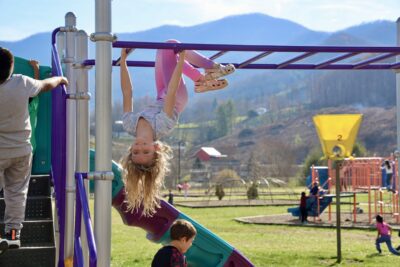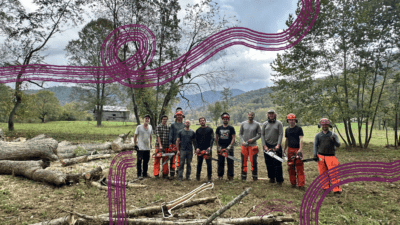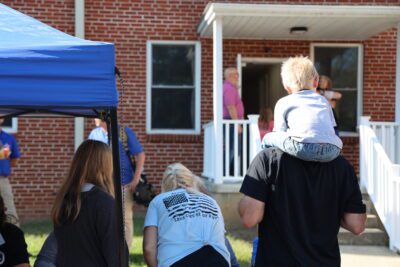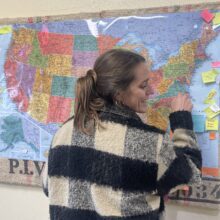If it’s hurricane season and you are in the south, it’s almost inevitable that at one point you will see a convoy of bucket trucks heading to post up where a storm is headed. When the power is down, these crews work around the clock to bring it back up.
According to the Hurricane Helene Damage and Needs Assessment from December of 2024, there were at one point 900,000 homes and businesses without electricity due to the storm. That is the reported number of buildings without power and doesn’t relay the number of people living in the dark.
![]() Sign up for the EdWeekly, a Friday roundup of the most important education news of the week.
Sign up for the EdWeekly, a Friday roundup of the most important education news of the week.
In this episode of “Running Towards Disaster,” we interview three electrical lineworkers who helped during Helene — two by land and one by air. We also visit a training facility to see these “climbing cowboys” at work. We are thankful for them, the hours they put in, and for their stories.
Click here for full audio transcription
Caroline Parker: This round of applause is from the North Carolina Senate floor on April 15, and Sen. Julie Mayfield is about to explain why. The recording is a little fuzzy, so lean in.
Mayfield: Madam president?
Lt. Gov. Rachel Hunt: For what purpose do you rise?
Mayfield: To add some color commentary to the courtesies of the gallery
Hunt: You have the floor.
Caroline Parker: Sen. Mayfield is from Buncombe County, and the district she represents was rocked by Helene in late September of 2024. She stands to address her fellow senators and looks to those above, being honored in the gallery.
Senator Mayfield: Thank you. So again on behalf of Sen. Daniel and myself, I want to welcome these good folks to our chamber today. You may have noticed the bucket trucks out front on the Jones Street side of the building. They’re here today because yesterday was Lineworker Appreciation Day here in North Carolina, and we are celebrating these hard working folks who help keep our lights on every day and who respond in times of emergency, as we have recently seen in western North Carolina.
Caroline Parker: Welcome back to “Running Towards Disaster,” a series of stories from people who. in times of crisis, head towards it to help. I’m Caroline Parker with EdNC.
Sen. Mayfield goes on to call out two of the lineworkers who are there in the gallery that day – Matt Martinka and Nathan Curlee. These lineworkers hiked two miles with their gear to get power back up at the Asheville VA Medical Center. We caught up with one of them outside the General Assembly Building, accompanied by another career lineman.
Nathan Curlee: My name is Nathaniel Curlee, and this would be my father, Christopher Curlee. I believe my great grandpa, grandpa, and my father, and my uncle have all been in linework. Like I said, I’m a fourth generation, once I got out of high school, I knew this is a career I wanted to get into. I went to Nash Community College. I did the line school there.
Caroline Parker: Nathan has been a lineworker at Duke Energy for four years and lives in Fairview, just southwest of Asheville.
Nathan Curlee: I got up, went to work that morning. And I think we we worked for roughly 30 days straight, 7/16 – so seven days a week, 16 hours.
Caroline Parker: If you lived in western North Carolina during this time, there wasn’t an Ingles parking lot you passed where bucket trucks weren’t camped out to help around the clock. Here is Nathan’s dad, Chris.
Chris Curlee : As as a father, you always wonder if you did a good job, and one of the greatest compliments you can get is to have a son follow in your footsteps. To know he worked for a company that’s going to take his safety first, that is critical, because I don’t worry about him. And then to watch — the storm was horrific in Asheville, but the family that came out of it, you know, because we were a long way away, he was the only one, only one of our family that was there, and they treat him like he was their own. You know, and the community supported them in their restoration efforts.
Caroline Parker: And restoration efforts, there were. According to a recovery assessment from December of 2024, there were at one point 900,000 homes and businesses without electricity due to the storm. That is the reported number of buildings without power and doesn’t relay the number of people living in the dark.
That same report also estimates $1 billion in damage to the wiring and infrastructure facilities across electrical providers in the area — a region serving nearly two million households.
The one thing that stood out while interviewing electrical lineworkers is that they all feel their crew is a family. Every lineworker feels a closeness to their coworker, their fellow ‘climbing cowboy.’
And there is no better place to witness this camaraderie than at Caldwell Community College and Technical Institute’s lineworker facility. Marty Walker is the energy program coordinator here and oversees the lineman and the newly added substation program. To describe their facility won’t do it justice, but we are out by the poles, watching students practice the climb.
Marty Walker: You always have a groundsman that sends material to your linemen on the pole, and they work together. That’s the one that’s usually in charge, telling him what he needs, and when to send it, and all that stuff. So you have a groundsman for cross arms as well.
They’ll use a bucket truck as much as possible. Most power companies will. They only climb when they have to climb because it’s much safer to do the job with a bucket truck, but we train them both ways.
Caroline Parker: The program is 14 years old, and so far, they have 738 graduates. Marty tells us 10 years ago there were 244,000 linemen across the states — now there are only 135,000.
Many graduates from Caldwell’s lineworkers program stay in the region and were instrumental in getting the lights back on for western North Carolina after Helene.
Tyler Rogers and Cory Bolick are two of those alumni. While working full time for their respective companies, they both at some stretch have returned to Caldwell to instruct, paying back the brotherhood that helped begin their careers.
You are about to hear from Tyler and Cory, graduates of Caldwell’s Lineworker Institute. We asked about their school, their storm experience, and the help they were able to offer after. We are thankful for their stories and the community college system that trains them. Here they are.
Tyler Rogers: My name is Tyler Rogers.
I work for Duke Energy on the transmission side. Our normal day, my crew in general, we’re considered a maintenance crew. So we go around and do inspections, so we maintain it and update it, and we work it energized, so that way we’re able to keep everybody’s power on as we’re fixing it.
We get prepared normally about a week in advance, but we don’t really know the significance of what’s going to happen. But Helene was a little different, because we was getting the rain and the storms before, so we was working weeks ahead of time, fixing damage that occurred already. We was working the night Helene hit, and we just had to go take shelter at the office and wait till the storm pass, and then we assess the damage. And we started driving, and we realized you can’t get vehicles anywhere. So we regrouped and got into our what we call it a storm room.
It’s a big room. We can pull up our grid and see everything that’s out and, you know, get everything live feed. So we called in helicopters and started patrolling with helicopters and four wheelers and figured we’d assess the damage, and then we’d come up with a game plan to go tackle it and get it done.
I was unique to this storm. So I have my ‘Fly on the Wire’ certificate, so I got designated to fly in the helicopter. I’m sitting in a helicopter with no doors on it, and I’m sitting on the side of the helicopter, leaning out, looking, we’re flying at a low level, and we’ll be probably 100 foot above the power line, so I’m flying within range to see with the naked eye and also, you know, being able to assess the damage thoroughly through the helicopter. If it’s a field, a wide open field, and I can’t see a good will land, and I’ll maybe walk through the woods, but 90% of time I’m flying and following my tablet and my GPS and I’ll drop coordinates and write the damage down for people to go back and put physical eyes and hands on.
So I was getting to see the damage from an air. So, they give me priority lines, is what we call them, because you can’t pick up smaller lines before you get these lines on so you have to work from priority to less priority. So I’ll fly the wire for the priority lines, and then I’ll figure out what damage needs to be done on those. And then I’ll go back, land at the office, give them my assessment and they’ll send crews out to go out there and physically fix the work. And then I’ll move on to the next priority and I’ll just keep working my way down until the end of the storm, until we get everything back on.
We flew for three weeks straight, and then probably 12 hours a day, and then I took the other four hours to probably come back and go through my paperwork and notes to divvy it out to crews to go fix the next day. So I was trying to stay a day ahead of them, far as damage, or if it was something, you know, really dangerous, I would call it in. We’d land, I’d call and they’d go out right away. But I tried to plan the next day for the crews on the ground.
I work with a lot of older guys and just so people maybe can understand that Helene for me, that’s the worst storm I’ve ever seen, far as in our area, and just worst storm in general, just devastation. And then they compare it to Hurricane Hugo, what hit North Carolina, and everybody I’ve worked with said this is, by far, on a power perspective, the damage to the power lines is way worse than Hugo.
When I come through, nobody knew what a lineman class was. I think I was the fourth class to come through here. I’ve decided to come back and help instruct it on my days off. So so that’s why I really support the school, because it’s helped me and changed my life. So I want to help other students.
Cory Bolick: My name is Cory Bolick.
I’m an electrical lineman. I’m an A class lineman, so yeah, I’m the guy that’s helping you get the lights back on. I work at Blue Ridge Energy out of Lenoir.
For me as a young man, I did relate sports to a career at that time. Similarities that it shares, regardless of what sport or team leadership that you may involve with, being a electrical lineworker, you can’t do it on your own. And it does take a team and whether it’s linemen or people in administrative or just all different levels. It takes everyone.
You don’t prepare for a hurricane the day before, that should be part of your routine of what we do. So I think with the way we operate, kind of minimize the scary factor. And I think you know, when you go home and you watch the news and you’re seeing these rain charts of 12, 13, 14 inches, you kind of start preparing your mind.
We knew it was going to be bad, we just didn’t know how bad. When you’re able to prepare your mind and prepare for the worst, it minimizes the ‘oh, what do we do?’ you know, because we are the ones that are called in for help. There’s no one else that can do it, as far as when it comes to getting the lights back on.
Once the storm arrived, we were already on standby, and they called us in, and it kind of slowly started making its landfall, so to speak, or in our county. And you know, we’re having some outages as it starting to enter, and so we’re working already. We’re already in the field trying to keep lights on, and we’re just maintaining it at this point, and then later on that day, it’s just like somebody turned the fans on. It just came in and never let up. And there for a while we were fighting it the best that we could, but eventually you got to know when to pull out.
And so we had to back up and punt a little bit. But once it was safe for us to get back out there, we immediately started back working. So yeah, I’ll never forget the while working, the trees are falling as you’re on a pole. You know, it’s literally falling on wire that you just put up, and they’re falling behind you and then there’s water, six, eight inches up on your tires and wheels. And, you know, there’s a lot of things to think about, and at the end of the day we’re responsible for our own safety. So yeah, that’s when it really set in. This is something I’ve never seen.
So we worked around here and we got our area back on and then we started going out to other counties to help where it was more worse.
Even for our county, Caldwell, all the way up to Sparta, we were very thankful to have, we call them brothers and sisters, relationships, but other co-ops that came in. We would have never been able to have the response that we had without those people. So we were very thankful for other co-ops and municipalities that were willing to take time and come help us. And likewise, when we went to Burnsville, which is where I call the bomb went off. That was who we were for them. So you know, priority was get our co-op back on, get our members taken care of and then, once we’ve achieved that, we’ll move out and help others.
And you know, we talk about how bad it is, but also the good outweighs the bad. The bad was a hurricane. It was destructive and lives were lost, houses were lost. But I think what is so satisfying to see is the community of how we come together and we helped each other out. That’s from people with their tractors, with their lawn mowers, whatever they had they were, ‘Hey, how can I help you? Or hey, you need help being pulled out?’ Like there was times that we needed help because we were stuck, and the homeowner come out and they’ll hook us up to their tractor and pull us through, you know. So I think that speaks loud as well during the hurricane is no matter how bad it is, it wasn’t enough to just cause people to lose hope.
If one’s looking to get into this industry, Caldwell is, in my opinion, the place to be. It’s the stepping stone that you need to be able to get into the field. I was able to instruct here for a couple years. So being a student and being an instructor, you understand both sides, and so you’re at the right place if you’re at Caldwell Community College.
Caroline Parker: You’ve just listened to stories from three electrical lineworkers who, during the storm and after, worked around the clock to help give people back their power. This is the second episode in our series, “Running Towards Disaster” from EdNC.
In our next episode, we will hear from a graduate of Southwestern Community College’s Outdoor Leadership program, who harnessed the energy of the outdoors community to get people what they needed in the wake of Helene.
This was a production by me, Caroline Parker, for EdNC. EdNC was established to be an independent source of news – providing data, and analysis about education for the people of North Carolina. In short, we tell the stories happening in our state’s classrooms and involving our state’s students. Music in this series is from the talented locals in Haywood, recorded at their Friday night event, Pickin’ in the Park. For a full bibliography of this episode and all of our coverage, go to EdNC.org.
Recommended reading



